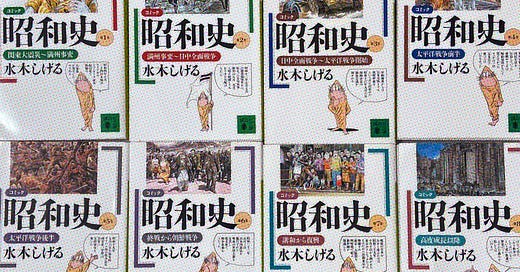Last night I finished Showa 1953-1989: A History of Japan, a thick manga book by the great Japanese cartoonist Shigeru Mizuki (1922-2015).
Written around the time of the death of the Emperor Hirohito in 1989, which officially triggered the end of what the Japanese call the “Showa” age, Showa: A History of Japan was originally a series of eight autobiographical mangas called Showa History (昭和史) that chronicled Mizuki’s life from the time of Hirohito’s ascension in 1926 to his passing over six decades later. From 2013 to 2015 the American publisher Drawn & Quarterly released an English translation of the books in a four-volume set. Ironically, this rerelease, nearly a quarter-century after their original publication, wound up coinciding with Mizuki’s own death.
There is something uniquely compelling about the idea of Japan’s Showa age. I found myself freshly seduced by it during a trip to the country last year, after having been away for a decade and a half. In 2020s Japan, the boxy characters of Showa, 昭和, are used mostly as a generic adjective to market nostalgia to Gen Xers and Millennials — there are “Showa cafes” with retro decor, junk food companies sell “Showa editions” of chips and candies done up in old-style packaging, eccentric “Showa toy stores” have shelves crammed with second-hand action figures, the best Godzilla is said to be “Showa Godzilla,” etc. A Japanese publisher called the Tatsumi Group sells a vast array of cheerful books full of colorful photographs documenting all sorts of random Showa-era stuff, from school supplies to “love hotels.” “Seeking nostalgia, warmth, comfort, and the flavor of simpler times... relive the golden age!” reads some promotional copy.
In this sense, “Showa” means Japan’s prosperous, consumerist 60s, 70s, and 80s — the era Mizuki’s last history book chronicles. Yet this modern usage is always slightly unnerving, coming from the fact that this is not Showa’s literal definition. In the Japanese era-dating system, Showa encompasses the entirety of the reign of Hirohito, every year from 1926 to 1989. Mizuki’s books choose to spend far more time on the early decades than the later ones; the volume I read, 1953-989 is a single book (three in Japan) documenting nearly 40 years of the postwar era. The previous three volumes (five in Japan), by contrast, document half that time, and are mostly about Japan’s role in World War II.
This makes sense, given the books’ are primarily the story of Shigeru Mizuki’s life. The second son of a middle class family, at age 21 he was drafted to fight for the emperor. Dispatched to defend Japanese-occupied Papua New Guinea, his platoons faced the wrath of the American island-hopping campaign in the lopsided warfare that defined Japan’s spiral into defeat. At one point his left arm had to be amputated without anesthetic.
In 1953-1989, Mizuki portrays himself as a man riddled with anxieties and trauma. He is a skilled artist whose talents are gradually rewarded, but has few meaningful relationships with friends or family (his parents are bossy and aloof, his marriage is arranged and lifeless). His only true joy is escapism; researching the supernatural creatures that come to define his comics, and endlessly longing for Papua New Guinea, which he visits frequently and fetishizes as a simple place of carefree, jolly people. The postwar modernization of Japan alienates him, and between vignettes of Mizuki’s life we are given news-report style stories of the various grotesque and upsetting things that dominated the Japanese headlines during the 60s, 70s, and 80s: Communists, serial killers, cults, plane crashes, corruption scandals and the like. Mizuki’s neuroticism becomes a sort of parallel to the anxieties of Japan as a whole; a country stretched between its desires for safety and stability, and the need to embrace the values of the democratic world order it fought against.
When the emperor Hirohito dies in 1989, Mizuki feels a sense of relief at the symbolism of the moment — the long trauma of the Showa era is finally over, an era that forced men of his generation to kill and be killed in a pointless war that left them mangled and disturbed, and ultimately ill-equipped to deal with the jarring new age of chaotic freedom that followed Japan’s surrender to the west.
Mizuki became rich and famous from the society Japan became, a society in which creative works of entertainment like manga served as cornerstones of a mighty cultural economy. To many Japanese people living today, his comics and characters embody the essence of Showa aesthetics and charm, lively and expressive and imaginative in a way the more self-serious Anime of the 21st century is not. Yet 1953-1989 reminds that many of the works of Showa postwar culture, the retconned Showa that begins in 1945, were produced by broken men who immersed themselves in their careers as a way of suppressing the guilt and anguish that comes from serving a fascist system so totalizing that even its destruction cannot be enjoyed.





